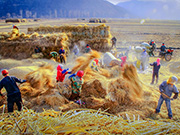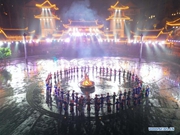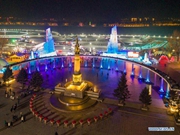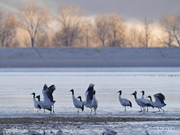

The ox is the second zodiac sign in the Chinese zodiac cycle, and 2021 is the Year of the Ox. As a sign of hard work and the spirit of sacrifice in Chinese culture, the ox also represents strength and sturdiness.
In ancient times, people used oxen to plow the fields. With its great strength, oxen were widely used for farming, transportation and military purposes. Legend has it that in the Warring States Era of ancient China, the Kingdom of Qi beat the Kingdom of Yan with a spectacular military tactic called "Fire Cattle Columns." In the period of the Three Kingdoms, the Kingdom of Shu used oxen to transport supplies on the plank roads in the war against the Kingdom of Wei.
In modern times, people like to use "Niu Qi Chong Tian" (Niu is the Chinese translation of Ox) to describe the success of a career and "Qi Chong Niu Dou", which means someone has an imposing manner, to describe the temperament of a person. They also use "Shi Du Qing Shen" (a mother cattle licks her baby) to show parents' affection toward their children.
Oxen in the ink-and-wash paintings of Chinese painter Pan Wenliang fully represent the characteristics of the art, giving the works a free-handed style and the spirit of life.
Born in 1971 in Nan'an city of southeast China's Fujian province, his painting works on the ox have characteristic of the Chinese ink-and-wash painting, which reflects the nature and brings a humanistic touch. A calligrapher and painter, Pan Wenliang's works have been displayed in art museums in Beijing and Paris. (Photo courtesy of Pan Wenliang)
 |

 Award-winning photos show poverty reduction achievements in NE China's Jilin province
Award-winning photos show poverty reduction achievements in NE China's Jilin province People dance to greet advent of New Year in Ameiqituo Town, Guizhou
People dance to greet advent of New Year in Ameiqituo Town, Guizhou Fire brigade in Shanghai holds group wedding
Fire brigade in Shanghai holds group wedding Tourists enjoy ice sculptures in Datan Town, north China
Tourists enjoy ice sculptures in Datan Town, north China Sunset scenery of Dayan Pagoda in Xi'an
Sunset scenery of Dayan Pagoda in Xi'an Tourists have fun at scenic spot in Nanlong Town, NW China
Tourists have fun at scenic spot in Nanlong Town, NW China Harbin attracts tourists by making best use of ice in winter
Harbin attracts tourists by making best use of ice in winter In pics: FIS Alpine Ski Women's World Cup Slalom
In pics: FIS Alpine Ski Women's World Cup Slalom Black-necked cranes rest at reservoir in Lhunzhub County, Lhasa
Black-necked cranes rest at reservoir in Lhunzhub County, Lhasa China's FAST telescope will be available to foreign scientists in April
China's FAST telescope will be available to foreign scientists in April